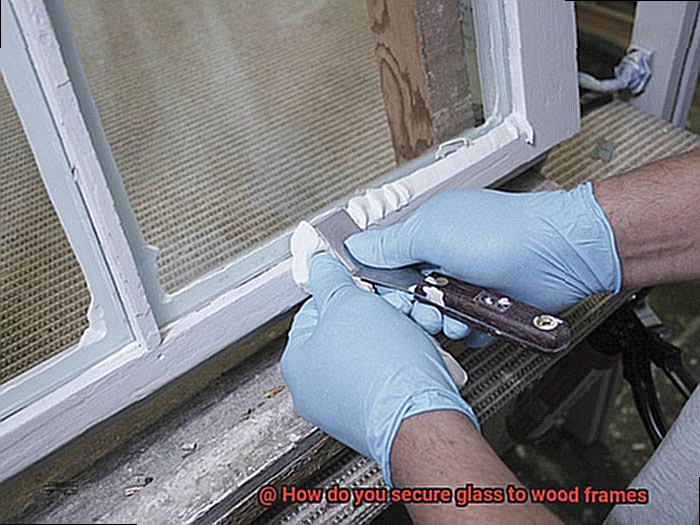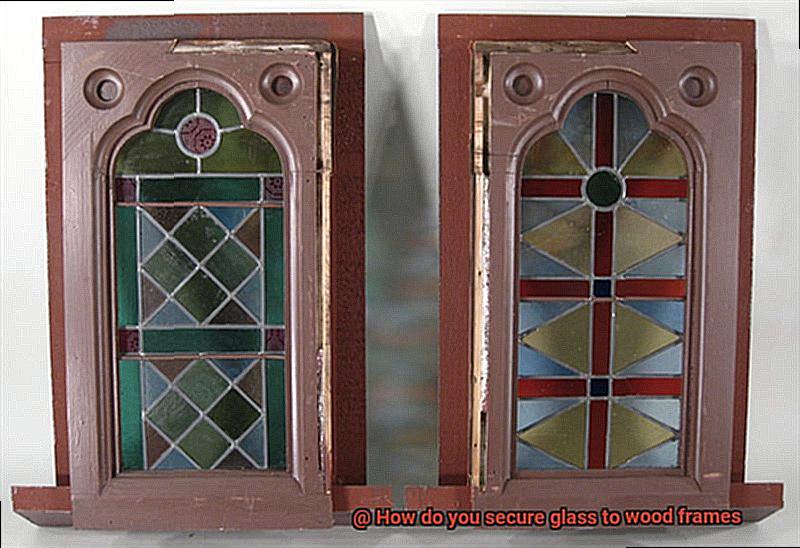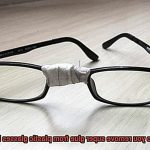Glass holds a magical allure, adding a touch of elegance and protection to cherished photographs, delicate artwork, and even furniture. But the burning question remains: how can we securely attach this fragile material to a sturdy wood frame? Fear not, my friend. In this blog post, we’ll embark on an exciting adventure into the world of securing glass to wood frames. Get ready to discover the hidden techniques that will guarantee a durable and professional finish.
Securing glass to wood frames is no simple task—it requires meticulous attention to detail and precise execution. From gathering the essential tools and materials to perfecting those final touches, each step plays a crucial role in achieving a secure and visually stunning result. We’ll explore everything from prepping the frame to adhering the glass and achieving that flawless finish. Our aim is to provide you with an all-encompassing guide that unravels this intriguing mystery.
So whether you’re an experienced artist looking to frame your latest masterpiece or an enthusiastic DIY lover eager to showcase precious memories, join us as we uncover the secrets behind securing glass to wood frames. Prepare for a journey filled with creativity and expertise that will empower you to confidently preserve and display your most treasured possessions. Let’s dive in.
Securing Glass to Wood Frames
Contents
- 1 Securing Glass to Wood Frames
- 2 Glazing Points: What Are They and How Do You Use Them?
- 3 Using Silicone Adhesive or Caulk to Secure the Glass
- 4 Benefits of Using Mirror Clips or Z-Clips
- 5 Double-Sided Tape and Foam Tape for Added Strength and Stability
- 6 Safety Precautions When Securing Glass to Wood Frames
- 7 Selecting the Right Method for Your Needs
- 8 Conclusion
Securing glass to wood frames is a crucial step in woodworking projects like windows, doors, and furniture. It ensures that the glass remains firmly in place, guarding against any potential damage or movement. There are several methods available for this task, each with its own advantages and considerations. Here’s an overview of the different techniques:
- Glazing putty: This traditional method involves using a mixture of linseed oil, whiting, and solvent to create a tight seal between the glass and the frame. Glazing putty provides excellent stability and weather resistance once it dries and hardens.
- Silicone adhesive: Silicone adhesive offers strong adhesion and flexibility, making it suitable for both interior and exterior applications. It comes in various forms, such as caulk-like tubes or liquid formulas that can be applied with a brush or spatula.
- Glass clips: These metal or plastic fasteners are installed around the perimeter of the glass at regular intervals. Glass clips provide a secure and adjustable method of securing the glass while allowing for easy removal if needed.
When securing glass to wood frames, accurate measurements and proper preparation are crucial. The frame size should match the dimensions of the glass precisely to avoid gaps or uneven surfaces. Thoroughly cleaning both the glass and frame before installation is essential to remove any dirt, dust, or grease that may hinder adhesion.
Safety precautions should also be taken when working with glass and adhesives. Wearing protective gloves and eyewear is advised to prevent injuries. Additionally, following the manufacturer’s instructions for the chosen method is crucial to achieve optimal results.
Glazing Points: What Are They and How Do You Use Them?
Glazing points, also known as glazier’s points or glazing clips, are small metal fasteners that play a crucial role in securely installing glass into wooden frames. Made of steel or brass, these tiny hardware pieces come in various shapes and sizes to accommodate different types of glass panels and frames.
To effectively use glazing points, it is important to follow a step-by-step process that ensures a secure and professional installation. The first step is to prepare the wooden frame by removing any old glazing points, nails, or debris. This ensures a clean and smooth surface for the glass to be installed.
Next, position the glass panel within the frame, ensuring it is centered and aligned properly. If needed, shims can be used to achieve an even fit. Selecting the right glazing points is crucial for a secure installation. Consider the thickness and weight of the glass when choosing the appropriate glazing points.
Once you have the right glazing points, start inserting them into the wooden frame. Hold a glazing point against the edge of the frame with its point facing towards the glass. Use a glazing point driver or a small hammer to gently tap the point into the wood until it is firmly secured. Repeat this process for each side of the frame.
To ensure that the glass is held securely in place, evenly space out the glazing points along each side of the frame. As a general rule of thumb, place a glazing point every 6-8 inches. It is essential to handle the glazing points with care to avoid any damage. Apply gentle pressure when tapping them in to prevent cracking the glass or denting the frame.
Once all the glazing points are secured, the next step is to apply a glazing compound or putty around the edges of the glass. This further secures the glass and provides a weatherproof seal. The glazing compound fills any gaps between the glass and frame, ensuring a tight fit and preventing air or water infiltration.
Using Silicone Adhesive or Caulk to Secure the Glass
Securing glass to wood frames using silicone adhesive or caulk is a reliable and effective method that offers both strength and flexibility. Before applying the adhesive or caulk, it is crucial to ensure that both the glass and wood surfaces are clean and free from any dust, dirt, or grease. This can be achieved by using a mild detergent or glass cleaner for the glass and sanding the wood frame if necessary.
To apply the adhesive or caulk, a caulk gun is recommended for precise and controlled application. It is important to apply a continuous bead along the edge of the glass, ensuring that it covers the entire perimeter of the glass. This ensures a strong bond between the glass and wood.
Once the adhesive or caulk is applied, firmly press the glass against the wood frame, making sure it aligns properly. It is essential to hold the glass in place until the adhesive or caulk dries. The drying time may vary depending on the brand, so it is advisable to follow the manufacturer’s instructions.
After the adhesive or caulk has dried, it is important to check for any gaps or loose areas between the glass and wood frame. If there are any gaps, additional adhesive or caulk can be applied to fill them in and secure the glass further.
When choosing silicone adhesive or caulk, it is crucial to select a high-quality product specifically designed for glass-to-wood bonding. Look for adhesives or caulks that offer excellent adhesion, durability, and resistance to moisture and temperature changes.
In addition to securing the glass, silicone adhesive or caulk also helps in sealing any gaps between the glass and wood frame, preventing water or air infiltration.
It is worth noting that silicone adhesive or caulk may not be suitable for all types of glass-to-wood applications. For heavy or large pieces of glass, additional mechanical methods such as clips or brackets may be necessary to provide extra support.
To ensure safety, it is important to follow precautions such as wearing gloves and working in a well-ventilated area when using silicone adhesive or caulk. Some products may emit strong odors or require specific handling procedures.
Regular maintenance is essential to ensure the longevity of the glass-to-wood bond. Periodically check the adhesive or caulk for any signs of deterioration or damage, and reapply if necessary.
Benefits of Using Mirror Clips or Z-Clips
When it comes to securing glass to wood frames, mirror clips or Z-clips are the go-to option for many. These clips offer a range of benefits that make them a popular choice among DIY enthusiasts and professional framers alike.
First and foremost, the ease of installation is a major advantage of using mirror clips or Z-clips. Unlike other methods that may require special tools or professional assistance, these clips are designed to be user-friendly. Even individuals with little to no experience in carpentry or framing can quickly and securely attach them to the wood frame. This convenience makes mirror clips or Z-clips a perfect option for anyone looking to tackle their framing project without any hassle.
Another significant benefit is the secure mounting provided by mirror clips or Z-clips. These clips are specifically designed to hold the glass firmly in place, eliminating any risk of movement or displacement. Made from durable materials such as metal or heavy-duty plastic, they ensure a strong and stable attachment. With mirror clips or Z-clips, you can rest assured that your glass will stay securely in place without any worries of it falling off or getting damaged due to inadequate support.
Using mirror clips or Z-clips also minimizes the damage that can occur during the installation process. Unlike other methods that may require drilling holes into the glass or frame, these clips usually only require small screws or nails to be inserted into the wood frame. This reduces the chances of cracking or damaging the glass, providing a safer and more reliable mounting solution.
Versatility is another advantage of mirror clips or Z-clips. These clips come in various sizes and shapes, allowing them to accommodate different thicknesses and dimensions of glass. Whether you have a thin mirror or a thick display case, mirror clips or Z-clips can easily adapt to your specific needs. Furthermore, they can be used with a wide range of wood frame materials such as pine, oak, or MDF (medium-density fiberboard). This flexibility makes mirror clips or Z-clips suitable for various applications, including mirrors, picture frames, and display cases.

Lastly, the aesthetic appeal of mirror clips or Z-clips is worth mentioning. These clips are designed to be discreet and minimalistic, ensuring that the focus remains on the glass or artwork rather than the mounting hardware. The slim profile of the clips adds to the overall visual appeal of the framed item. If you value both functionality and aesthetics in your framing projects, mirror clips or Z-clips are an ideal choice.
Double-Sided Tape and Foam Tape for Added Strength and Stability
Double-sided tape and foam tape are excellent choices when it comes to securing glass to wood frames, as they provide added strength and stability. These adhesive tapes are specifically designed to bond surfaces together, offering a secure and long-lasting hold.
Double-sided tape is a versatile option that can be used in various applications, including securing glass to wood frames. It consists of a thin layer of adhesive on both sides, sandwiched between two layers of backing material. This unique design allows the tape to stick to both the glass and the wood surface, creating a strong bond. The tape is available in different thicknesses and strengths, allowing you to choose the one that suits your specific needs.
On the other hand, foam tape is specifically designed to provide cushioning and support while bonding surfaces together. It is made of a flexible foam material with adhesive on both sides. The foam acts as a shock absorber, reducing the risk of breakage or damage to the glass. Additionally, foam tape helps distribute the weight evenly, preventing any stress points that could weaken the bond.
To effectively use double-sided tape or foam tape for securing glass to wood frames, follow these steps:
- Clean the surfaces: Ensure that both the glass and the wood frame are clean and free from dust, dirt, or any other debris. Use a mild detergent and water solution to clean the surfaces if necessary. Dry them thoroughly before proceeding.
- Cut the tape: Measure the length of tape needed for each side of the glass frame and cut it accordingly. Make sure to leave a small overlap at each end for a secure bond.
- Apply the tape: Peel off one side of the backing material from the tape and carefully position it along one edge of the wood frame or glass panel. Press it firmly in place, ensuring good contact between the adhesive and the surface.
- Secure the glass: Carefully position the glass panel onto the wood frame, aligning it with the tape. Apply gentle pressure to secure the bond. Repeat the process for the remaining sides, ensuring that the glass is aligned properly.
- Allow time for bonding: Give the adhesive tape some time to bond and set. Follow the manufacturer’s instructions for recommended curing or drying time.
Safety Precautions When Securing Glass to Wood Frames
When it comes to securing glass to wood frames, safety should always be the top priority. Glass can be fragile, and accidents can happen if proper precautions are not taken. Here are some important safety measures to consider:
- Protective Gear: Wear safety goggles, gloves, and a dust mask to protect your eyes, hands, and respiratory system from potential hazards.
- Work Area Preparation: Ensure that the work area is clean, well-lit, and properly ventilated. Remove any clutter or obstacles that may cause accidents or hinder your movement.
- Glass Handling: Exercise caution when handling glass. Lift and carry the glass with both hands, distributing the weight evenly. Avoid dragging or sliding the glass across surfaces to prevent scratches or breakage.
- Use Proper Tools: Use specialized tools designed for working with glass and wood frames. Glass cutters, clamps, screws, and adhesives specifically formulated for securing glass should be used.
- Secure Work Surface: Before starting any work, make sure the work surface is stable and secure. An unstable or wobbly surface can lead to accidents and damage to the glass or frame.
- Adequate Lighting: Ensure that there is sufficient lighting in your work area to clearly see what you are doing. Insufficient lighting can lead to mistakes or accidents.
- Sharp Edges: Glass edges can be extremely sharp, so handle them with care. If necessary, use sandpaper or a file to smooth any rough edges.
- Proper Ventilation: Some adhesives or sealants used to secure glass can emit harmful fumes when applied. Work in a well-ventilated area or use a fan or exhaust system to remove any potentially dangerous fumes.
- Secure Glass Panels: When securing glass panels to wood frames, ensure they are properly supported and held in place. Clamps or temporary supports can be used until the adhesive or sealant has fully cured.
- 10. Allow Sufficient Drying Time: Follow the manufacturer’s instructions for the adhesive or sealant being used and allow sufficient drying time before moving or handling the glass frames. Rushing this step can result in weak bonds or damage to the glass.
Selecting the Right Method for Your Needs
Selecting the right method for your needs can be a daunting task. When it comes to securing glass to wood frames, there are several factors to consider. First and foremost, you need to determine the type of glass and frame you are working with. Different methods may be suitable for different materials.
One common method is using adhesive or glue specifically designed for glass and wood bonding. There are various types of adhesives available, such as epoxy, silicone, or polyurethane-based adhesives. Each type has its own characteristics and strengths, so it’s essential to choose the right one based on your specific needs.
Epoxy adhesives are known for their strong bonding capabilities. They create a durable and long-lasting connection between glass and wood frames. However, epoxy can be challenging to work with as it requires precise mixing ratios and relatively longer curing times.
Silicone adhesives offer flexibility and excellent resistance to temperature changes and moisture. They are easy to apply and provide a secure bond between glass and wood surfaces. However, they may not be as strong as epoxy adhesives in terms of sheer strength.
Polyurethane-based adhesives provide a balance between strength and flexibility. They have good bonding properties and can withstand environmental stressors such as temperature fluctuations or movement of the wood frame. These adhesives are often used for structural bonding applications.
Aside from adhesive options, another method of securing glass to wood frames is through the use of mechanical fasteners such as screws or clips. This method involves drilling holes in both the glass and wood frame and then attaching them together using the fasteners. Mechanical fasteners provide a secure connection and can be useful when dealing with heavy or large pieces of glass.
When choosing between adhesive or mechanical fasteners, consider factors such as the size and weight of the glass, the desired aesthetic appearance, and the level of permanence required. Adhesive bonding tends to be more visually appealing as it eliminates the need for visible fasteners. However, mechanical fasteners may offer more strength and stability, especially in high-stress applications.
hV5TGpCuGXg” >
Conclusion
In conclusion, securing glass to wood frames is a meticulous process that demands attention to detail and the application of appropriate techniques. Fortunately, there are several methods at your disposal, each with its own advantages and considerations.
One such method is glazing putty, a traditional approach that creates a tight seal between the glass and frame. This not only provides stability but also ensures resistance against the unpredictable whims of weather. On the other hand, silicone adhesive offers both formidable adhesion and flexibility, making it suitable for both interior and exterior applications. Its versatility knows no bounds.
For those seeking a secure yet adjustable solution, glass clips come to the rescue. These handy contraptions allow you to fasten the glass firmly while still permitting easy removal if necessary. Talk about convenience.
However, before embarking on any installation endeavor, accuracy in measurements is paramount. Proper preparation and thorough cleaning of both the glass and frame are essential prerequisites for success. Safety precautions should never be overlooked when working with delicate glass and potent adhesives.
If you crave ease of installation coupled with secure mounting, look no further than mirror clips or Z-clips. These options not only minimize damage during installation but also offer aesthetic appeal that will leave your guests in awe. Plus, they can accommodate various thicknesses of glass without breaking a sweat.
When extra strength and stability are non-negotiables, double-sided tape or foam tape steps up to the plate. By bonding surfaces together with tenacity, these options ensure that your glass remains steadfastly attached to its wooden counterpart. Just remember: clean surfaces are crucial for optimal adhesion.
In selecting the perfect method for your specific needs, consider various factors such as the type of glass and frame you’re working with, desired aesthetic appearance, level of permanence required, as well as environmental stressors like temperature fluctuations or movement.
By following these guidelines diligently and taking all necessary safety precautions along the way, you can confidently secure glass to wood frames.






